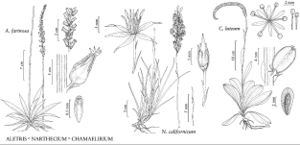Narthecium
Fl. Angl., 127. 1762.
| Taxon | Illustrator ⠉ | |
|---|---|---|
 | Aletris farinosa Narthecium californicum Chamaelirium luteum | Barbara Alongi Yevonn Wilson-Ramsey Barbara Alongi |
Herbs, perennial, from slender, creeping rhizomes; roots fibrous. Stems simple, glabrous. Leaves mostly basal, astride rhizomes, equitant, overlapping; blade narrowly linear, apex acute; cauline leaves 3–6, reduced. Inflorescences terminal, racemose, simple. Flowers greenish yellow to yellow, glabrous; tepals persistent, 6, spreading, erect in age, distinct, weakly 3-veined, glandless, linearlanceolate, margins scarious; stamens 6; filaments white, very densely pubescent; anthers dorsifixed, versatile, 2-locular, linear, introrse; ovary superior, 3-locular, lobes fused into long-pointed stylar beak, septal glands absent; stigma minutely 3-lobed; pedicels bracteolate proximally, usually with small bracteole near middle. Fruits capsular, weakly 3-lobed, oblong-lanceolate, thin walled, dehiscence loculicidal. Seeds pale-yellow, filiform-ellipsoid, narrowly bristle-tailed at both ends. x = 13.
Distribution
Primarily north-temperate regions
Discussion
Species 4–8 (2 in the flora).
The widely disjunct species of Narthecium (1–5 in Europe, 1 in eastern Asia, and 2 in North America) are morphologically and ecologically quite similar (A. A. Stabursvik 1959; W. B. Zomlefer 1997).
Narthecium has sometimes been included in the segregate family Melanthiaceae; based on morphology, anatomy, and karyology, it is best placed in its own family, Nartheciaceae (J. D. Ambrose 1975, 1980; P. Goldblatt 1995; W. B. Zomlefer 1997; A. L. Takhtajan 1997; M. N. Tamura 1998b), and order, Nartheciales (J. L. Reveal and W. B. Zomlefer 1998). The Nartheciales, considered basal to the Liliaceae in the broad sense and to the monocotyledons, includes only Nartheciaceae, with five genera: Aletris Linnaeus (14 species, eastern Asia and North America), Metanarthecium Maximowicz (1, eastern Asia), Lophiola Ker Gawler (2, eastern North America), and Nietneria Klotzsch ex Bentham (1, northern South America). In this flora, Lophiola is treated with the Haemodoraceae; see page 47.
Flowers of the common European species Narthecium ossifragum (Linnaeus) Hudson, which are fragrant, homogamous, and produce no nectar, are known to be pollinated by raindrops. The conspicuous filament hairs, common within the genus, trap pollen, and self-pollination occurs when raindrops accumulate around the filament hairs, allowing pollen to float to the stigma (O. Hagerup 1950; M. C. F. Proctor and P. F. Yeo 1972; M. C. F. Proctor et al. 1996). Such pollination probably occurs also in the North American species.
Steroidal saponins of Narthecium are thought to cause liver disease (icterus) in nonpigmented sheep via a deadly photosensitivity (A. A. Stabursvik 1959; R. Hegnauer 1962+, vol. 2, pp. 284–286).
Selected References
None.
Lower Taxa
Key
| 1 | Stems 2.5–4.5 dm; flowering racemes compact, 3–6 cm; pedicels 4–5 mm; tepals 4–7 mm; anthers yellow; e United States. | Narthecium americanum |
| 1 | Stems 3.5–6 dm; flowering racemes open, 8–15 cm; pedicels 8–15 mm; tepals 7–10 mm; anthers brick red; w United States. | Narthecium californicum |
"broad" is not a number."thin" is not a number."thicker" is not a number.